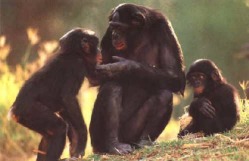Reproduction - Key Reproductive Features

As it is for almost all mammals, the mother does most of the childcare. They carry the baby, groom them, feed them, and educate them. The babies are completely dependant on the mother until they are about 3-4 years of age. They still travel with her and depend on her until adulthood. Even though a child may achieve independence, they will have social connections to his mother until the end of their lives. Males especially use their mother for emotional support when they are trying to establish themselves. When they are feeling “blue”, they seek out the mother for comfort that only a mother can provide.
Because many young travel with the mother, the bonds between siblings are also very strong. These bonds remain intact even until adulthood. The older siblings carry and play with the infants. If the mother dies, the older siblings will take her place and care for the young.
Males do not provide any direct care for the young, though they are gentle and playful with them. Males indirectly provide protection for their young by engaging in border patrols, which may help protect the young from potential dangers.
The rank of the mother can tell the way that her offspring will behave. If the mother is in a high rank and is calm, then the offspring will be calm. If the mother is nervous, then her offspring will be scared of the other chimpanzees.
Young males do not move to other troops, they inherit their homeland. There is no fixed pattern, the transition of father to son is uncommon, and relatives would not recognize each other as that. Females may also remain in their native home, but they may move to another troop after reaching maturity.
